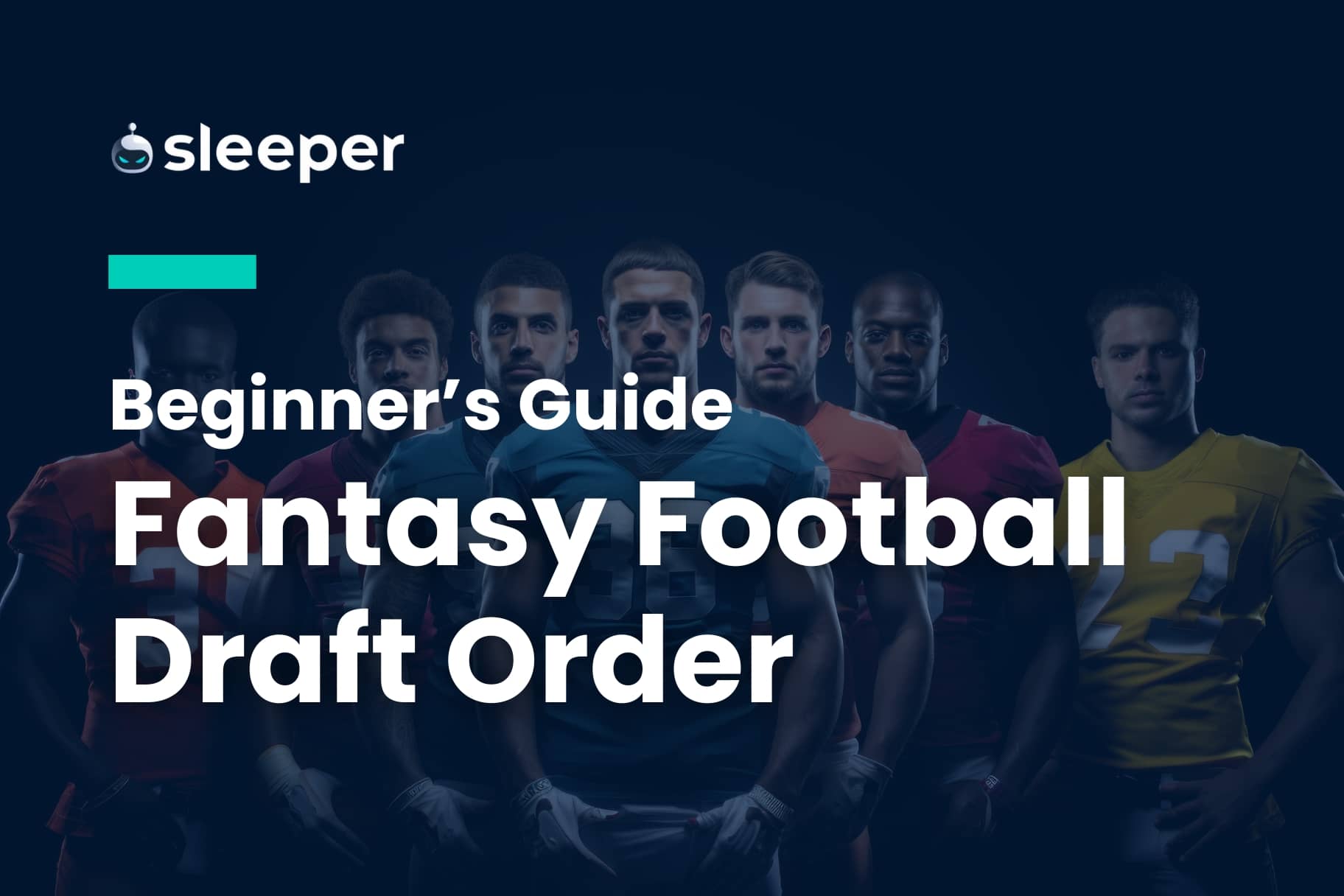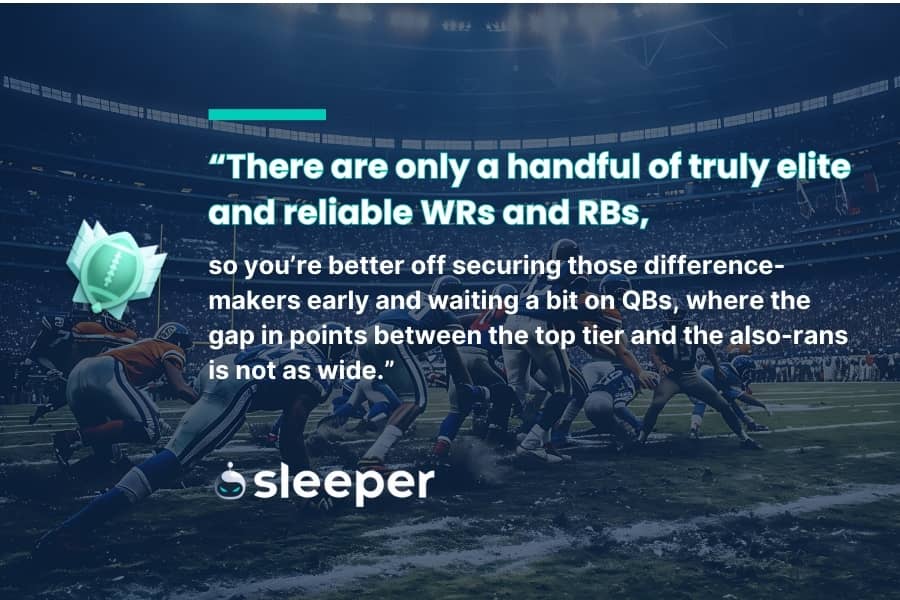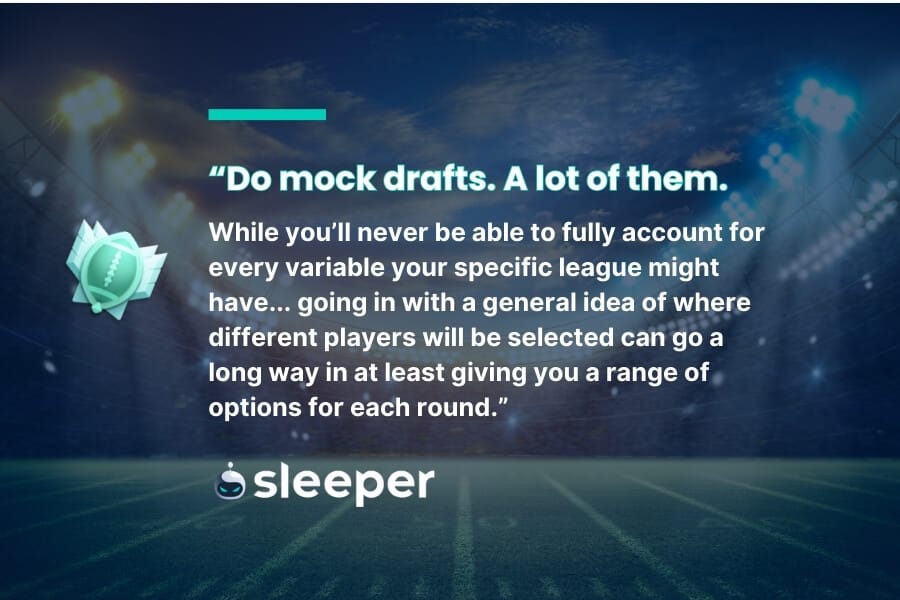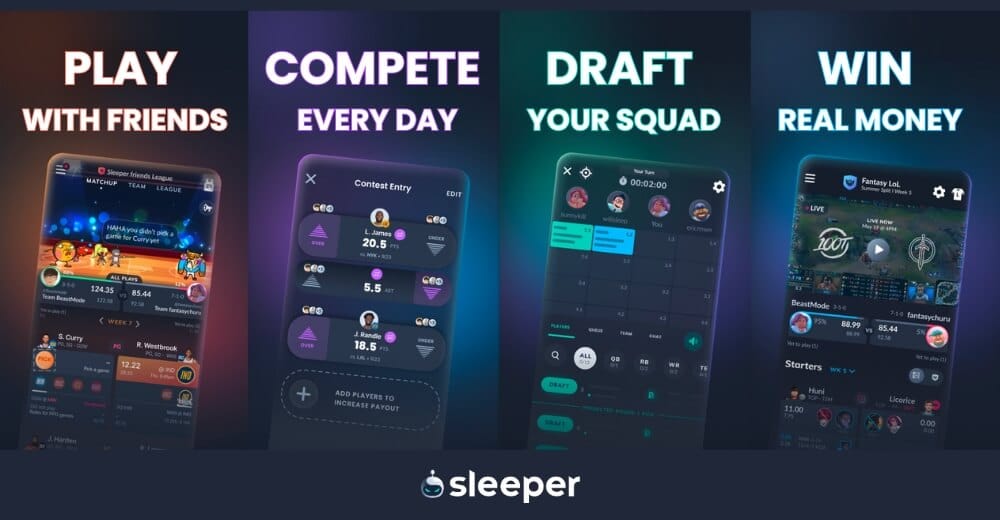Are you ready to craft the ultimate draft strategy and dominate your fantasy football league? This article will be your best ally in picking your dream team

Fantasy football drafts are a core element to any league, in any format. And while you might not be able to win a league on draft night — trades, astute waiver moves and free agent pickups all play a role along the way — you can certainly lose one if you leave yourself at a stark disadvantage from the jump. That’s what makes your draft strategy and execution so valuable as you embark on another (or your first) fantasy football odyssey.
There’s no one, singular winning method when it comes to fantasy football drafts, but certain frameworks will give you a better chance of success than others. That’s why we’re here: To help you fully prepare to take on your friends and foes and claim that elusive fantasy league title.
Draft Types
There are multiple ways to set up your league. Snake drafting for redraft leagues (your team is your team for the season, and then you start all over again the following season; as opposed to keeper or dynasty leagues) has long been the most common format. Auction drafts have become more prevalent in recent years, though.
Deciding the best draft order requires taking a closer look at each draft type:
Snake Draft
The most traditional format has managers pick in order one round, then in reverse in the following round and so on until all rounds (typically 15 or 16) are complete. If you’re in a 12-team league and you have the first overall pick, you’ll be waiting until pick No. 24 until the draft swings back your way for you to select again. Then you’ll kick off the third round with the No. 25 pick overall.
If you’re picking 12th, you’ll go back-to-back at 12 and 13, but then have a seemingly endless wait until 36, when you pick next. Strategies will differ based on your draft position, which is usually selected at random either by a commissioner or an order generator.
Auction Draft
In this format, every player starts out available to every manager. There’s no agonizing over having to wait out a round to see if a player drops to you. Getting a player you want solely depends on whether you’re able to outbid your competition. Managers take turns nominating a player, and then the spending frenzy ensues.
Each manager begins with the same draft budget (the default option on Sleeper is $100 in pretend money), and how you wield it is up to you.
You can go big on a few stars and round out the rest of your squad on the cheap. Or, you can play it cool and try to land some bargains when everyone else has already blown their bankrolls. Regardless, draft order is not a factor in auction drafts.
Dynasty Draft
If you’re in it for the long haul, a dynasty — or startup — league, is the way to go. You’re planning for multiple seasons like a real-life GM, not just one.
Younger players and incoming rookies may have greater value than they would in more traditional drafts due to their longer-term outlooks, although you’ll still need to strike the right roster balance and feature enough established talent if you want to win right away. The strategy differs greatly in a dynasty draft, where startups can be conducted either via snake or auction draft.
The Ideal Fantasy Football Positional Draft Order

A standard lineup in fantasy football features a quarterback, two running backs, two wide receivers, a tight end, a flex (RB/WR/TE), kicker and a team defense/special teams unit, plus six bench spots.
Some leagues customize starting lineups by adding a third WR or a second flex, (and superflex leagues will allow you to start a second quarterback in a flex spot). Others will also include individual defensive players as an additional wrinkle, but for the sake of getting started, let’s stick with the basic framework. In Sleeper fantasy leagues, for example, just about everything is customizable.
Despite quarterbacks regularly scoring more points over the course of the season than skill position players, it rarely makes sense to draft a QB in the first couple rounds or blow your auction budget on one. That’s due to positional scarcity across those skill positions.
There are only a handful of truly elite and reliable WRs and RBs, so you’re better off securing those difference-makers early and waiting a bit on QBs, where the gap in points between the top tier and the also-rans is not as wide.
With all that said, the following is a solid approach for a 15-round snake draft. Remember, everything is dependent on where you’re picking, who’s available, who has slipped to you unexpectedly and other league-specific variables.
Rounds 1-4: Star RB or WR
If you want to assure yourself of having the likes of Patrick Mahomes, Josh Allen, Jalen Hurts or Lamar Jackson, then go for it. These are ultimately your decisions. But consider what that will mean for the quality of your skill players, who regularly occupy roughly five times the roster space of a QB in your starting lineup. This is the place to load up on those — especially in a PPR or half-PPR league, where they are more valued. Unless QB TDs are worth six points, you can wait on the throwers.
Rounds 5-6: RB/WR/TE/QB
Now is when you’ll want to start considering a QB or TE, depending on the RBs and WRs still available. Chances are that stud TEs like Travis Kelce and Mark Andrews have been taken by now, but the emergence of some young tight ends (Sam Laporta and Trey McBride among them) has bridged the gap and provided some more flexibility on when to go for the “other” pass catchers.
Rounds 7-9: The unsexy but proven RB/WR
Every year there are veteran players whose upside may be capped but whose production remains steady if not unflashy. If you want to lock in players with a solid floor, now’s the time.
Rounds 10-11: High-upside rookies, handcuffs
Rookies in decent spots and backups who are an injury away from becoming potential league-winning fixtures make for promising bench wild cards. At this point, the sure things are likely off the board, so swing big and hope that one (or more) pan out to give your team the edge.
Rounds 12-13: Backup QB, late-bloomer RB/WR/TE
It helps to have backup plans, especially if you’ve waited longer than expected to pick a QB and aren’t fully satisfied with the option. There’s also always a handful of post-hype skill players who are worth taking fliers on to see if they’ll come close to realizing their potential.
Rounds 14-15: Defense/Special teams and Kicker
There are those who will bite early on these at the expense of building depth at the skill positions. There’s so much unpredictability on a weekly basis when it comes to defense and kicker and so much upside elsewhere you could miss by jumping prematurely that it’s prudent to wait it out.

Fantasy Football Draft Advice and Tips
Here are a few more significant pointers ahead of draft day.
Know your league rules
Every league is different. While standard scoring is followed in many leagues, PPR leagues are becoming more of the norm. Some commissioners like to institute their own twists, and those can be incredibly influential when it comes to the scoreboard and draft order.
Does your league offer bonus points (generally given to QBs who hit 300 yards passing in a game or skill players who hit 100 rushing or receiving yards)? Are passing TDs worth as much as rushing and receiving TDs? Is your league a PPR (point per reception) or half PPR (0.5 points per reception) league? Or is it non-PPR?
If you have a handle on the scoring system and lineup construction going into your draft, you’ll be better served when surveying your player options when it’s time for you to pick.
Be aware of bye weeks when you’re drafting
The NFL typically has its bye weeks (weeks when teams are off, thus your fantasy players are off) clustered between Weeks 5 and 14, and it’s no secret when each team is idle. Use that information to your benefit.
It might severely hamper your team if your starting RBs and WRs all share the same bye week, for example. Or maybe you’d just prefer to get it all over with at once and potentially punt on a week (or have the hubris that you can pull off a W with waiver wire fodder or squad depth).
Either way, bye weeks matter and should be factored into your decision making, even if they’re not the end-all.
Draft your team close to the start of the season
Nothing is worse than drafting your team early in the preseason, feeling good about your studs … and then watching one tear his ACL before the regular season even begins. That leaves both you and him quite literally playing on one leg.
If you can draft your team as close as possible to the night of opening kickoff, you’ll give yourself the best chance at limiting the potential catastrophes that could occur before the season starts.
Have a backup plan
You might go into your draft anticipating things to go a certain way — and then suddenly be on the clock with all of your expected potential choices already selected. A panic pick is an unsettling way to conduct your draft and can quickly put you on tilt.
So be calm, take a deep breath and go in with some strategies. If you wanted an RB1 in the first round, but you’re left with a second-tier pool of options, don’t be afraid to pivot.
Wait until the end for kickers
Trust us — you don’t need to reach for a kicker. Every year, a free agent kicker winds up being among the best in class (in 2023, the Dallas Cowboys’ Brandon Aubrey was indeed K1 after entering the season as a widely undrafted player).
Beyond that, the difference between Aubrey and K10 was roughly 30 fantasy points total, depending on how leagues score kicking points. That comes out to a difference of less than two points per week. Sure, it’s preferable to have the top dog, especially one in a high-scoring offense, but at what cost on draft night?
Check the schedule for matchups
All the rankings and ADP (average draft position) calculators in the world won’t account for the schedule. And while it may be hard to pinpoint precisely which teams will struggle and which ones won’t going into a new season, you can hedge, allowing yourself to spot the players who have some cushy matchups in a row.
Don’t overthink it for the early rounds, but when considering upside picks later in the draft, the schedule can be your friend.
Mock? Yeah!
Do mock drafts. A lot of them. While you’ll never be able to fully account for every variable your specific league might have (you never know who is going to reach for what), going in with a general idea of where different players will be selected can go a long way in at least giving you a range of options for each round. Your draft will hardly mimic a mock identically, but you’ll at the very least go in with proper context and expectations.
Pro tip: Sleeper let's you do as many mock drafts as you want, and it's free.

Frequently Asked Questions
Who is the best first overall pick in fantasy football?
Going into the 2024 season, it’s hard to argue against San Francisco 49ers running back extraordinaire Christian McCaffrey — no matter the draft or league format. The sheer volume of touches in an RB-friendly offense, his ability to contribute in both the running and passing game and his stranglehold over the 49ers’ goal-line touches make him as reliable a fantasy star as there is in the game.
While you want to secure a generational season with your first-round pick, it’s almost equally as important to protect your downside and go with a player who is consistent and has a high floor. In McCaffrey’s case, he can offer both (provided he stays healthy), and unless another position is overemphasized in your league’s custom settings, CMC is the pick.
When should I draft a QB in fantasy football?
Going QB early could severely limit your squad in the skill positions. You’ll still get a good option or one with significant upside in rounds 5-6 (or even later) if you have the patience to wait it out.
What does streaming mean in fantasy football?
You’ll have your roster staples, but for the positions where you’re not as settled (or if you’ve had a star player suffer a major injury), you might be playing the waiver wire/free agent game consistently, where you’ll “stream” players on a weekly basis. What works for Week 5 may not work for Week 6, for instance, or maybe you’re hampered by bye-week absences, so you’ll drop and add to put forth your strongest possible lineup. Streaming is most commonly used for defenses and kickers but can be applied to any position.
What is a handcuff in fantasy football?
A handcuff is a star player’s direct backup (most frequently referring to running backs) — and someone that’s great to stash on your bench if you already have the incumbent starter.
Every player is one bad injury away from being shelved, and if you already drafted the man who’s in line to take on the bulk of those touches, or at least have him high on your free-agent radar, you’ll be set up for success.
I’m a fantasy football beginner; what steps should I take?
Start with this comprehensive primer on fantasy football. Beyond the previously advised mock draft preparation, you can also pull up data featuring ADP (average draft position) across different platforms and leagues to further your education on where you can expect certain players to be picked.
Most importantly, be up to date on who is injured and/or suspended and what players’ status is for the season before you draft. Don’t be that manager who smugly picks the big-name RB only to learn minutes later (through deserved ribbing and heckling) that he’s out for half the season.
You’re Ready To Be A Fantasy Football Draft Expert
With all of this information in tow and all of these steps to follow, you should now be ready to rule your league — or at least handle your draft with precision. All you need now is the platform on which to carry it all out. Look no further: Sign up for Sleeper to start playing, joining either by signing up via our website or downloading the app.
Sleeper has special features across its season-long fantasy football games that you won’t find anywhere else, and it’s also the best fantasy football and most unique gaming platform for daily fantasy sports, differing from its DFS competitors, for instance, by offering snake drafts for every week of the NFL season through Daily Draft. No matter what kind of fantasy football experience you’re seeking, you can enjoy all the benefits and special features that Sleeper offers, such as the offline draft option, where you can hold your draft off the platform, input your picks manually and then play on per normal.




